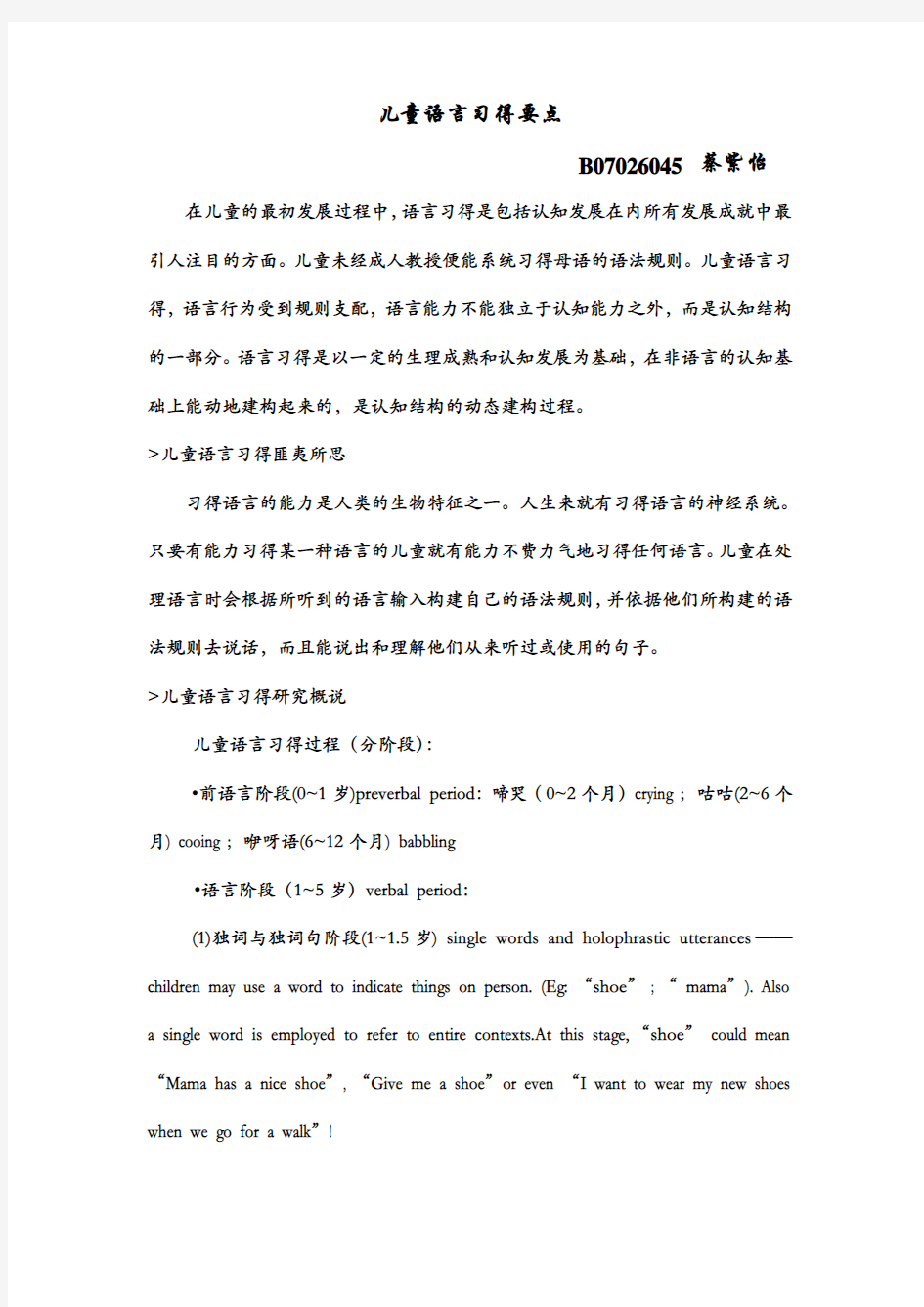儿童语言习得要点

- 1、下载文档前请自行甄别文档内容的完整性,平台不提供额外的编辑、内容补充、找答案等附加服务。
- 2、"仅部分预览"的文档,不可在线预览部分如存在完整性等问题,可反馈申请退款(可完整预览的文档不适用该条件!)。
- 3、如文档侵犯您的权益,请联系客服反馈,我们会尽快为您处理(人工客服工作时间:9:00-18:30)。
儿童语言习得要点
B07026045 蔡紫怡在儿童的最初发展过程中,语言习得是包括认知发展在内所有发展成就中最引人注目的方面。儿童未经成人教授便能系统习得母语的语法规则。儿童语言习得,语言行为受到规则支配,语言能力不能独立于认知能力之外,而是认知结构的一部分。语言习得是以一定的生理成熟和认知发展为基础,在非语言的认知基础上能动地建构起来的,是认知结构的动态建构过程。
>儿童语言习得匪夷所思
习得语言的能力是人类的生物特征之一。人生来就有习得语言的神经系统。只要有能力习得某一种语言的儿童就有能力不费力气地习得任何语言。儿童在处理语言时会根据所听到的语言输入构建自己的语法规则,并依据他们所构建的语法规则去说话,而且能说出和理解他们从来听过或使用的句子。
>儿童语言习得研究概说
儿童语言习得过程(分阶段):
•前语言阶段(0~1岁)preverbal period:啼哭(0~2个月)crying ; 咕咕(2~6个月) cooing ; 咿呀语(6~12个月) babbling
•语言阶段(1~5岁)verbal period:
(1)独词与独词句阶段(1~1.5岁) single words and holophrastic utterances ——children may use a word to indicate things on person. (Eg: “shoe” ; “ mama”). Also a single word is employed to refer to entire contexts.At this stage, “shoe” could mean “Mama has a nice shoe”, “Give me a shoe”or even “I want to wear my new shoes when we go for a walk”!
(2)双词句阶段(1.5~2岁)two word phrases ——in this stage children use sentences of one ang two words length.(Eg: “My book”which means “This is my book”or “Give me the book”.
(3)电报式言语阶段(2~2.5岁)telegraphic speech ——sentences are adult-like but function words are often left out.(Eg: When Daddy come home?——When will Daddy come home?
(4)基本似成人阶段(2.5~5岁)essentially adult-like language
>儿童语言习得理论
1.行为主义——外在
Behaviourist——children learn primarily through imitation and patterns of positive or negative reinforcement from their carers. B.F.Skinner
行为主义的理论认为儿童的言语行为主要通过刺激与反应来建立。正确的言语行为被强化,错误的言语行为得到纠正,从而使儿童逐渐获得正确的使用语言的行为。现代研究表明纠错与强化儿童第一语言习得过程中并不起关键作用,如:Child : Nobody don’t like me.
Mother : No, say “Nobody likes me.”
Child : Nobody don’t like me.
(This type of exchange is repeated 8 times)
Mother : No, now listen to me, carefully, say “Nobody likes me.”
Child : Oh! Nobody don’t LIKES me.
2.心灵主义——内在
★3.认知主义——内外在相互影响
Cognitive——children develop their linguistic competence alongside their ability to understand the world around them. J.Piaget
>儿童语音的发展
1.初期(发音不清):咕咕声——元音a,o,u……
咿呀声——a,o,u,i,b,p,m 无j,v……
单词句:从广泛发音局限到所学语言的音
2.中后期(从发音不清有错误到比较清楚正确):单词句后期——多词句
★发音错误:a.省略错误:hurt——urh xi——西红柿
b.合并错误:pacifier——paf
c.替换错误:kiss——gik
d.重复错误:kitty——titty
区别两个音:Child: Where is Mytul?
Father: You mean Mytul?
Child: No, Mytul !
Father: Oh, Michael?
Child: Yes, Mytu.
>儿童语义的发展(1~5岁)
1.1岁左右真正第一个词的判断标准:理解;会用(语境);稳定;来自成人语言。
2.初级阶段的词的特点:名词(大部分)→动词→形容词→社
交词(肯定、否定)→功能词(虚词)[动态的、周围的事物的发音容易掌握] A.Namingthings:ball,dog,juice,,Mummy,milk,apple,cat,car,baby,shoe,biscuit……
B.Action/Events:give,put,sit,stop,go,up,down……
C.personal/Social:yes,no,hi,bye-bye……
D.Modifing things:dirty,nice,more,this,that,all gone……
3.词义和所指(之物)的错误
例:Child A:duck——duck or water 未分明
Child B:white——snow 词义的缩小underextension
Child C:ball——balls,marbles,wheels,cement mixers 词义的扩大overextension 4.建立一个小词典(在脑中)
例:A. put , give 有共同点:物体的转移,所有权的转移……
※Put me my dolly.
※I’ll give the spoons here.
Give me the forks.(setting the table)
Mark put my doll in the toilet!(asking for her doll)
B. ※You come my car over here,please!
The door opened.
I opened the door. Overgeneralization过度(分)规则化
注:※是错句。
>儿童语法的发展(单词句——多词句)
1.平均句长Mean Length Of Utterances(MLU)
2.6岁儿童MLU
